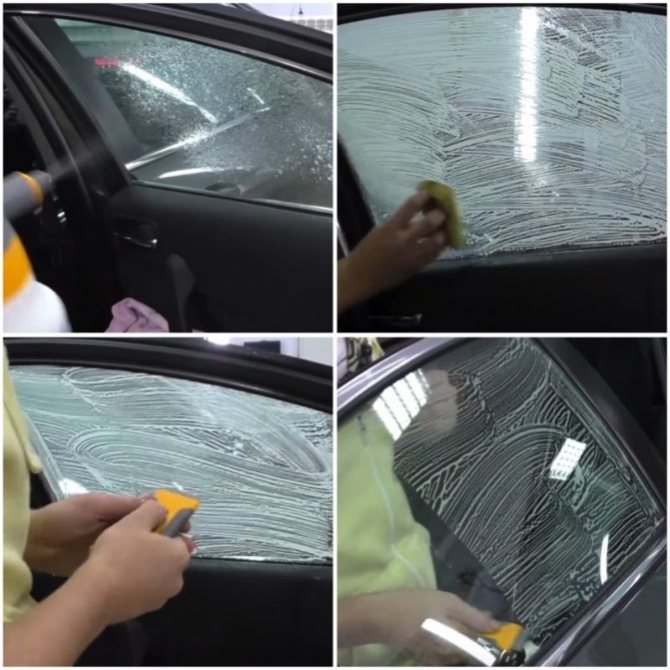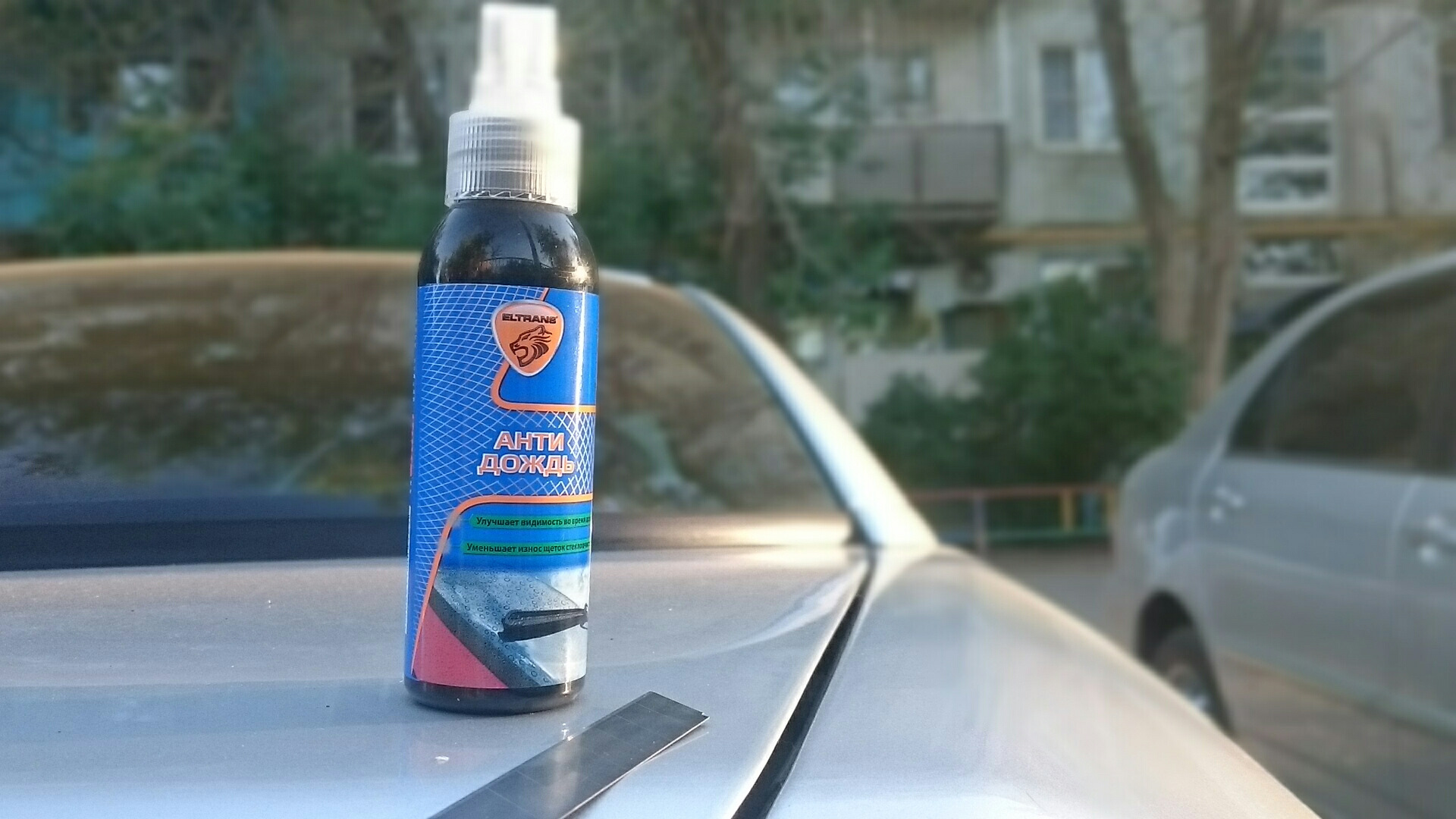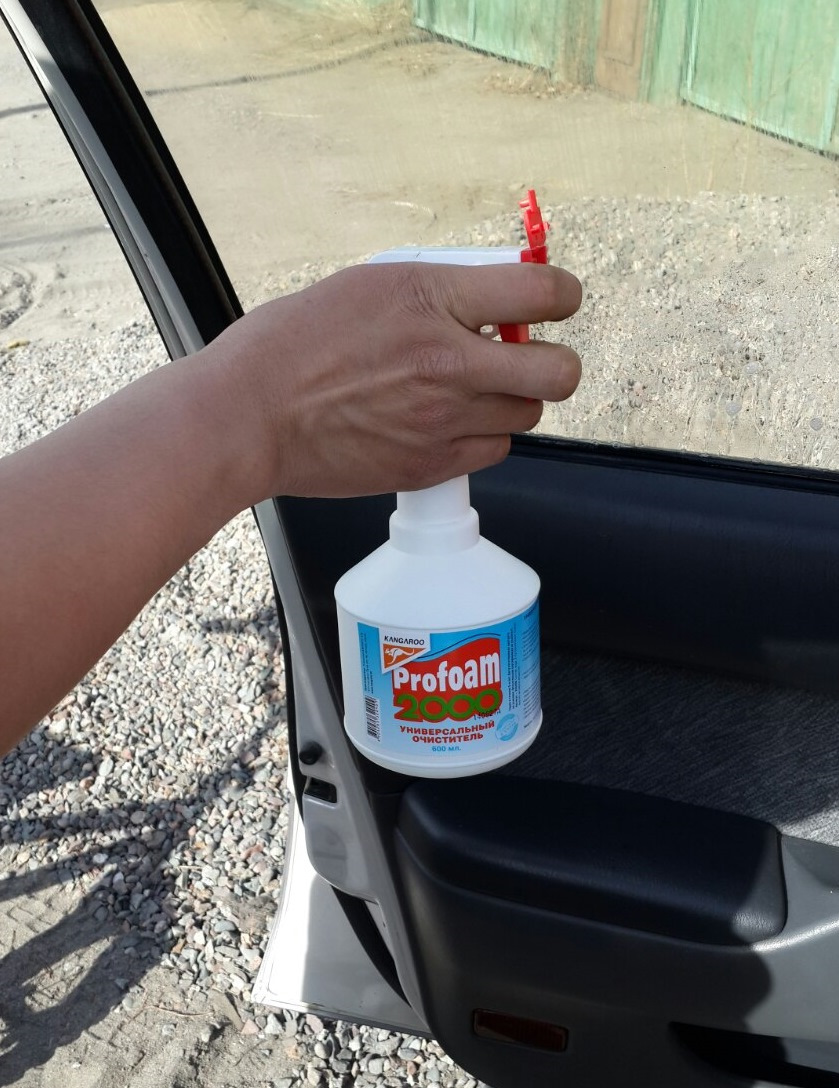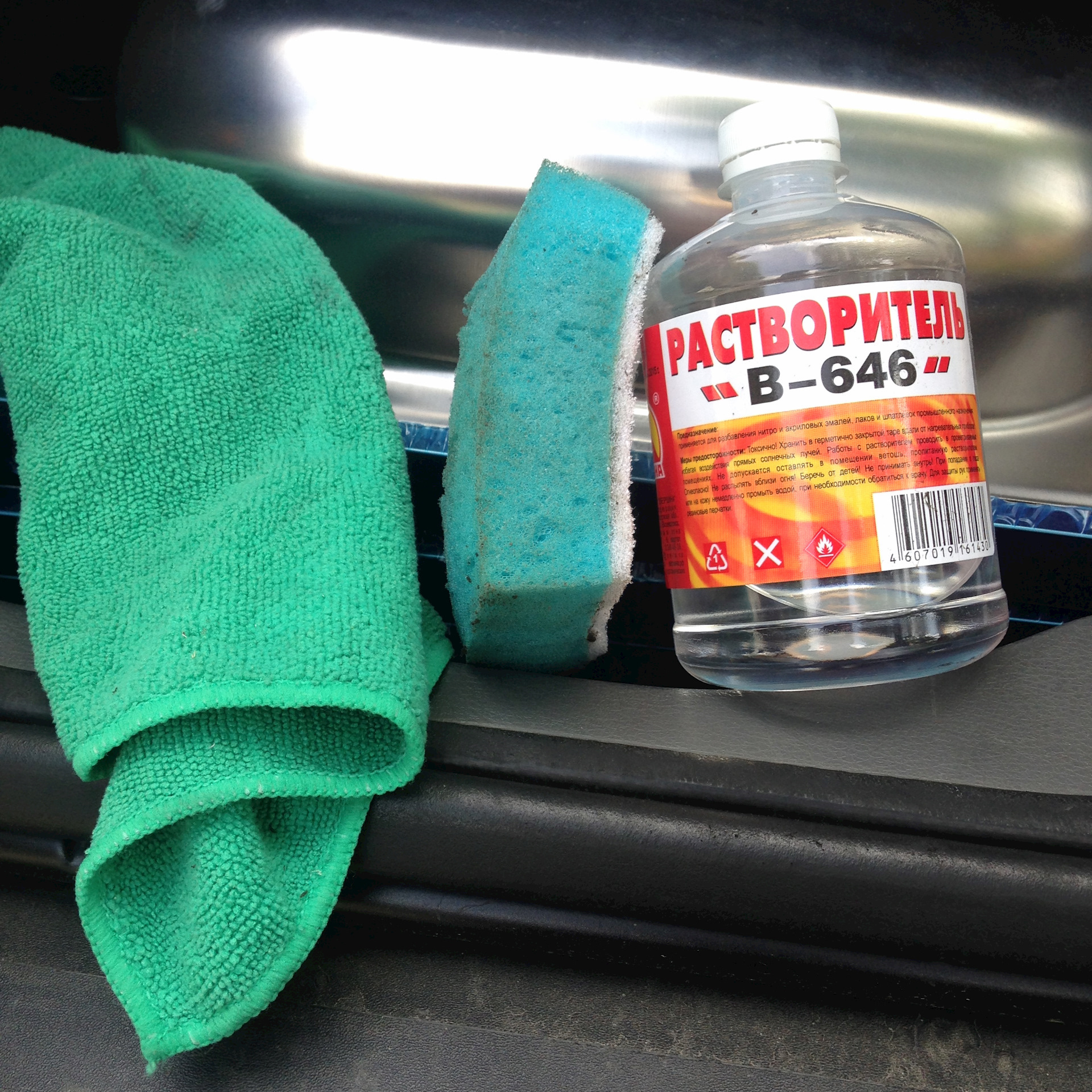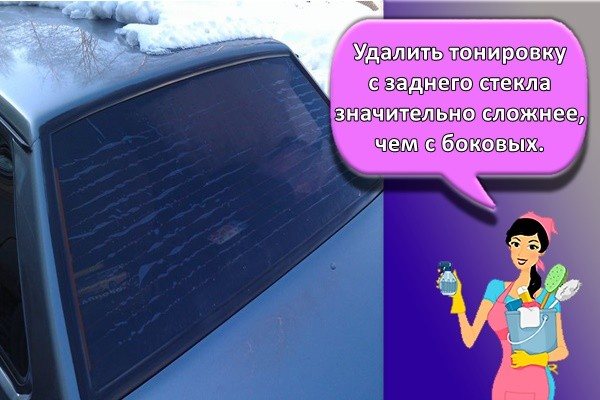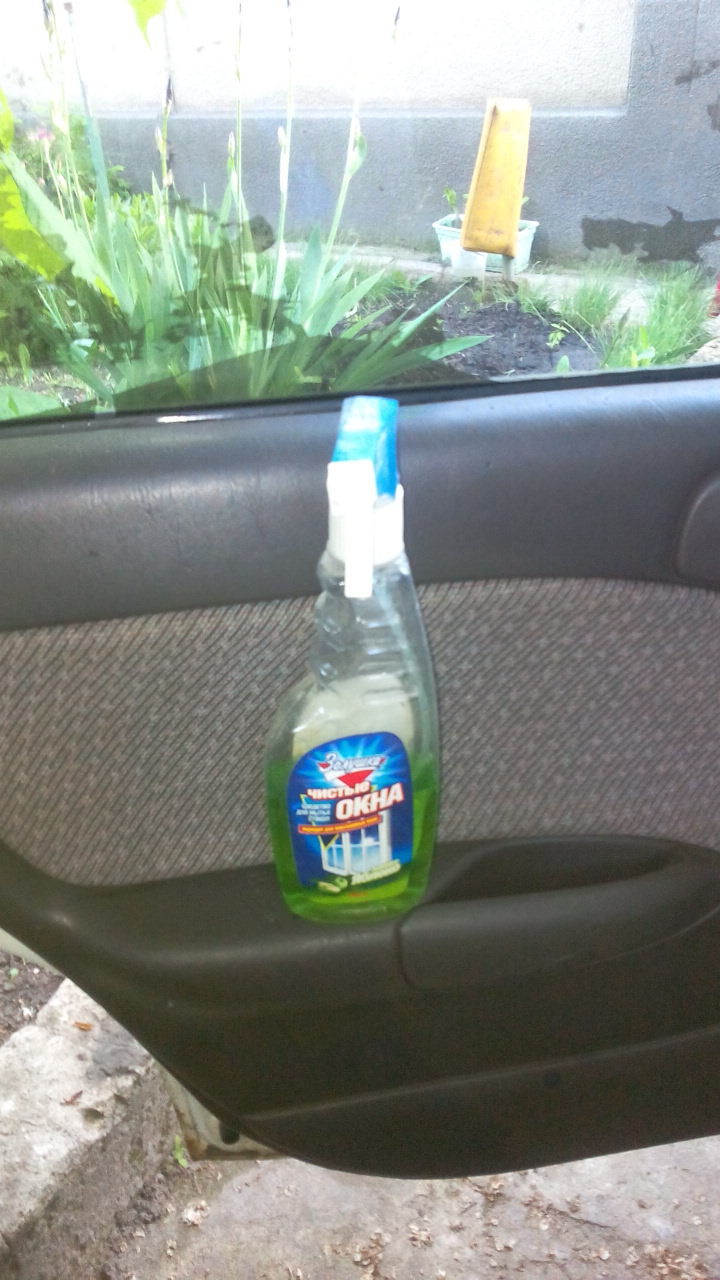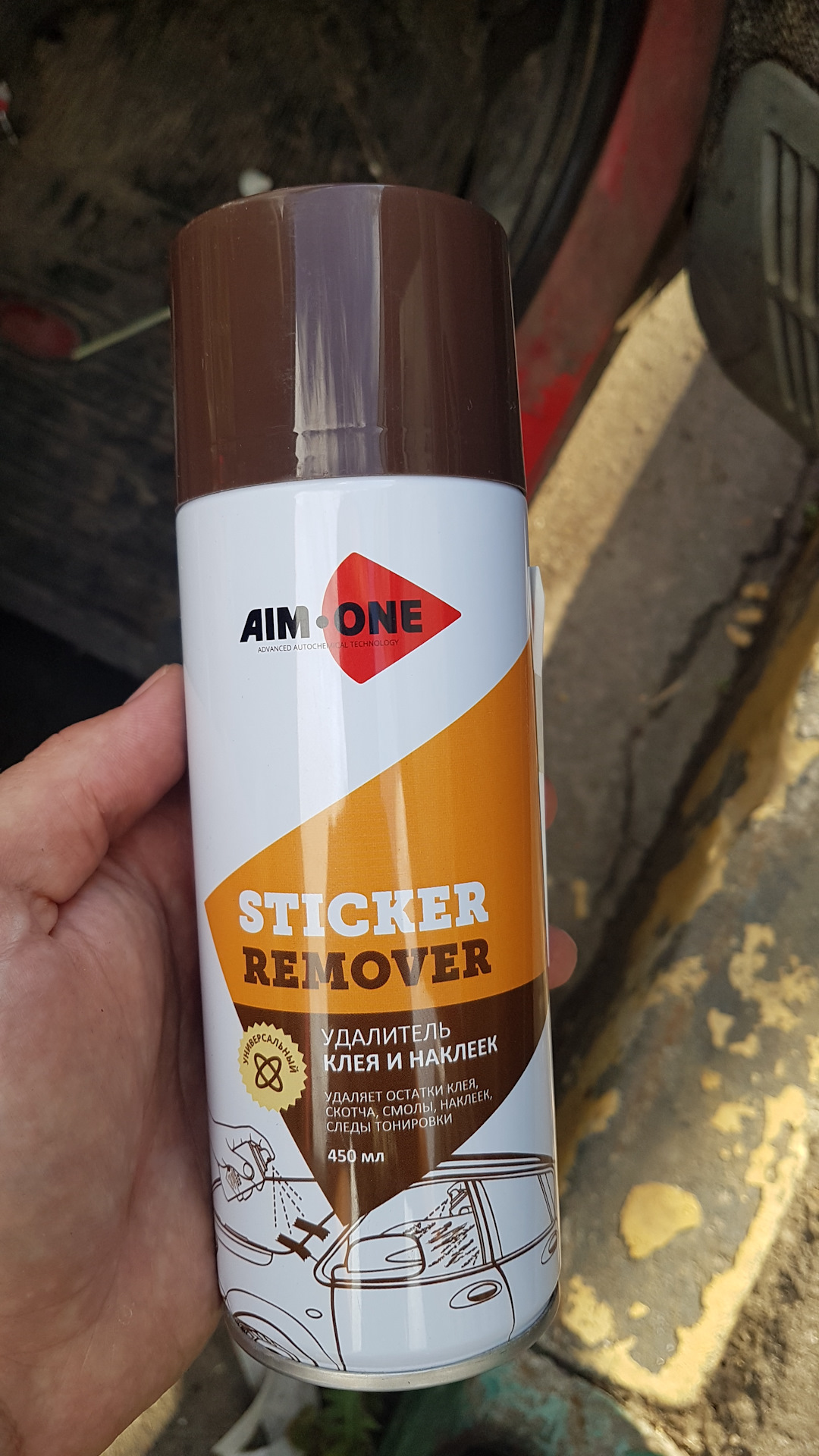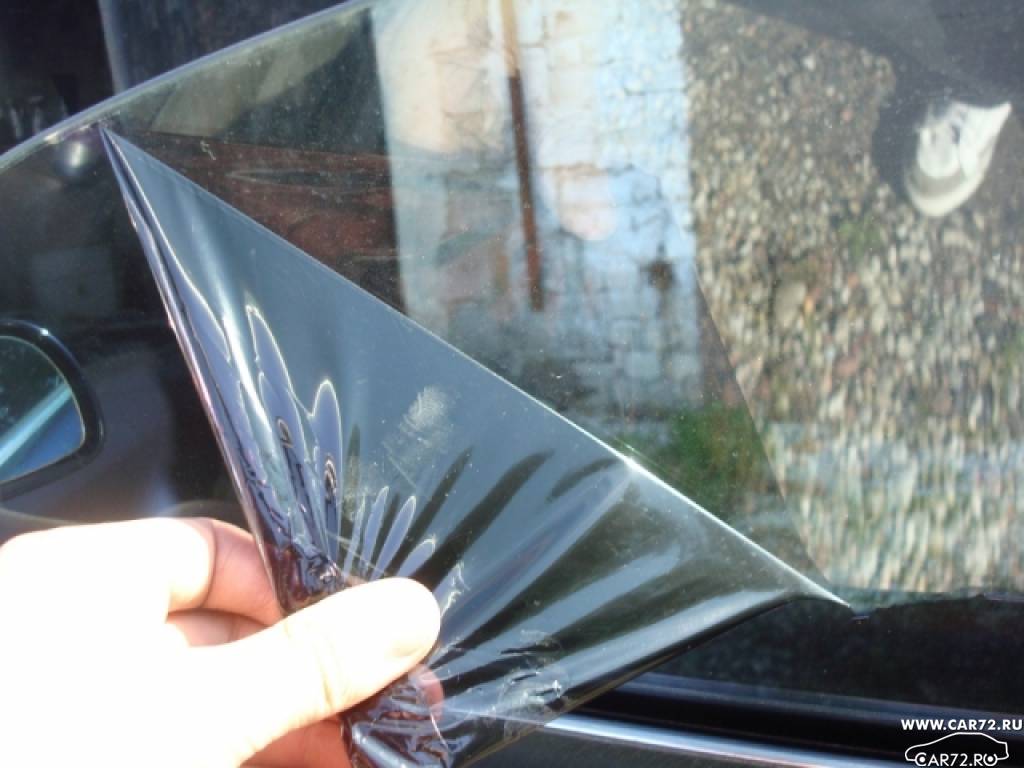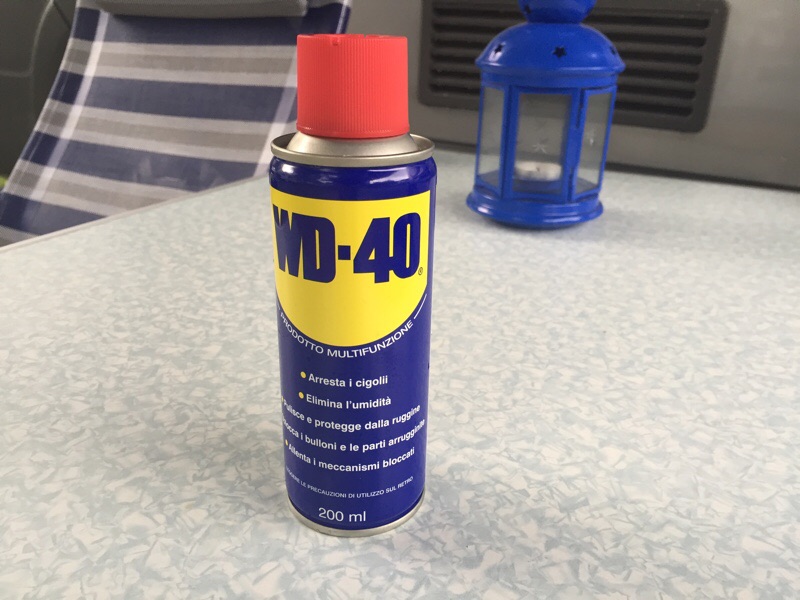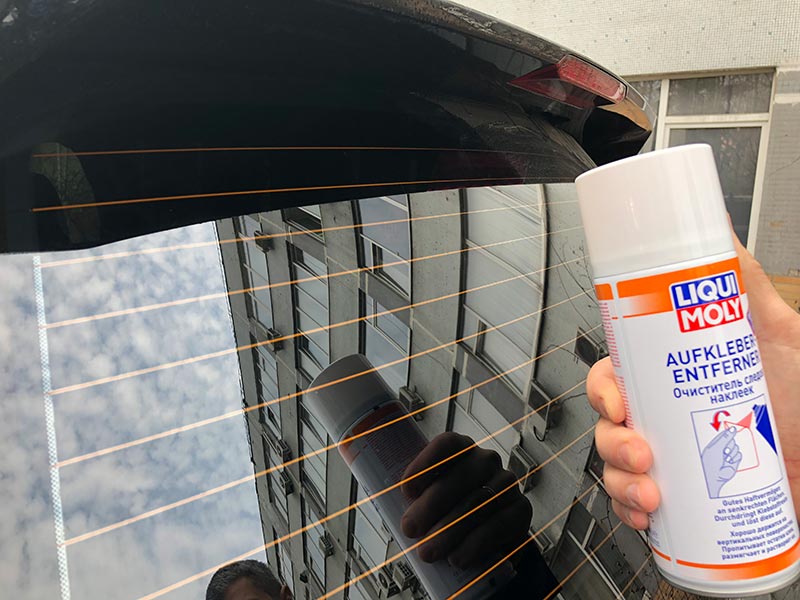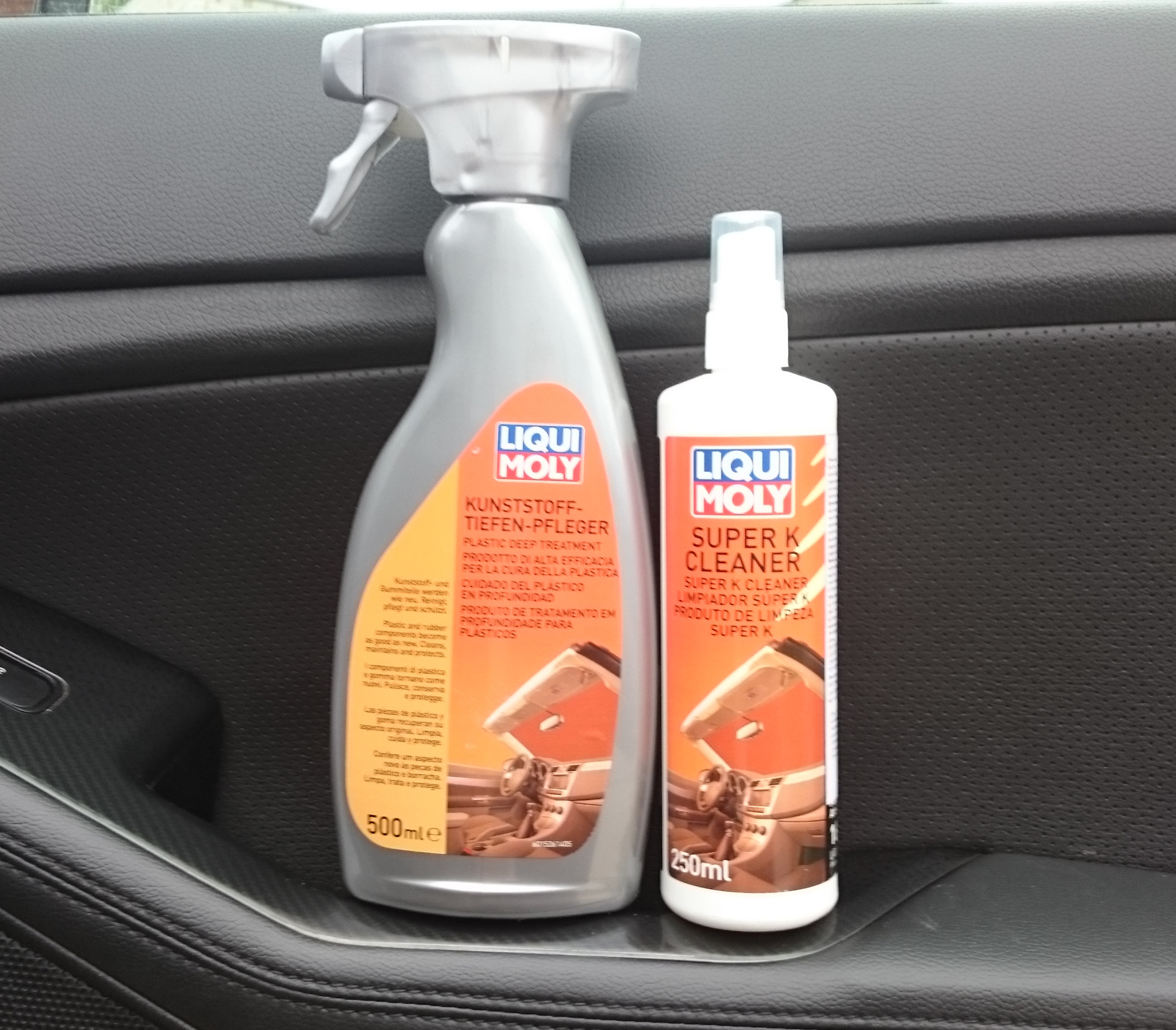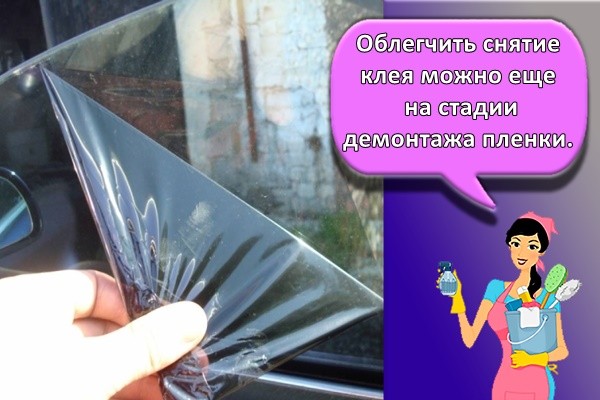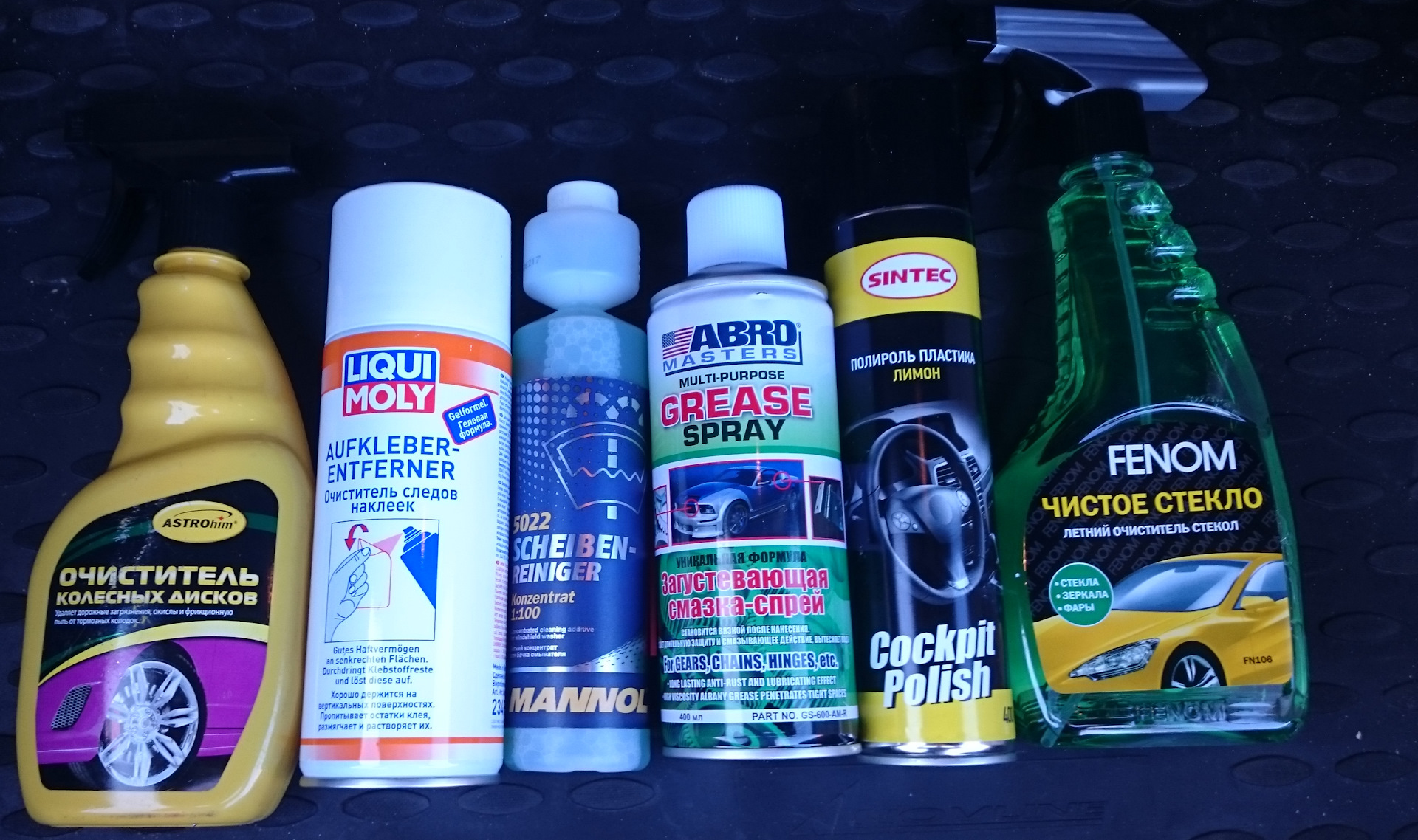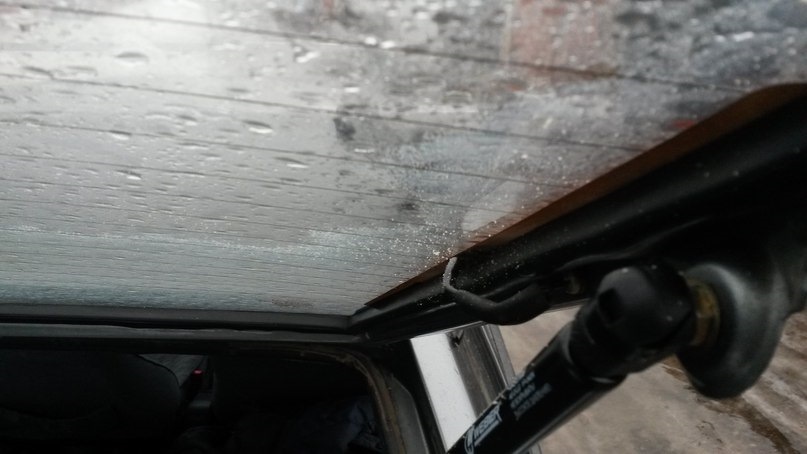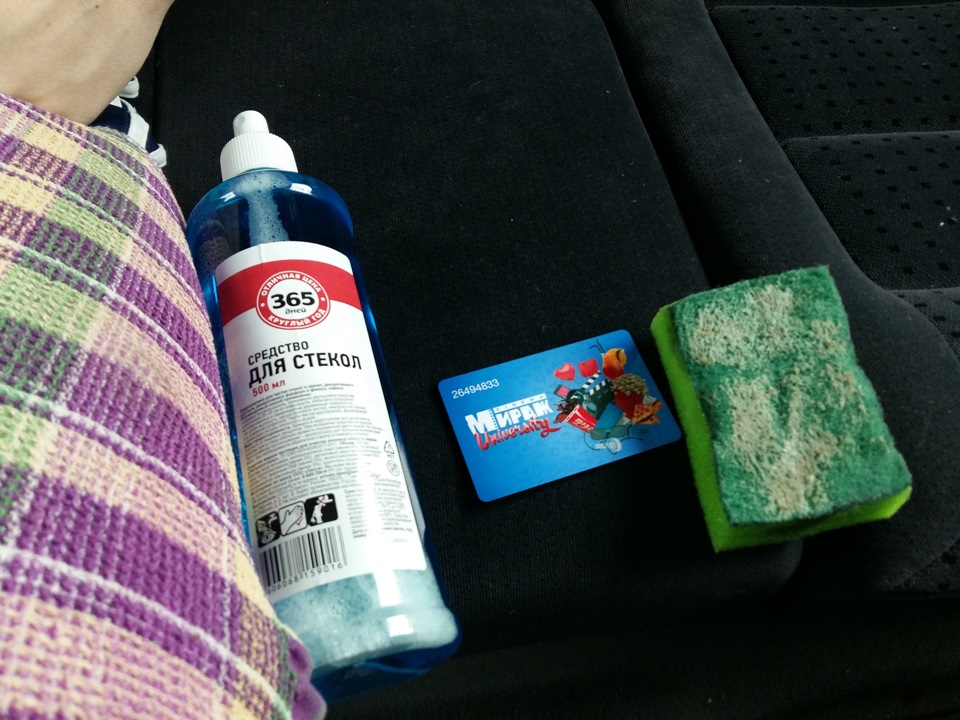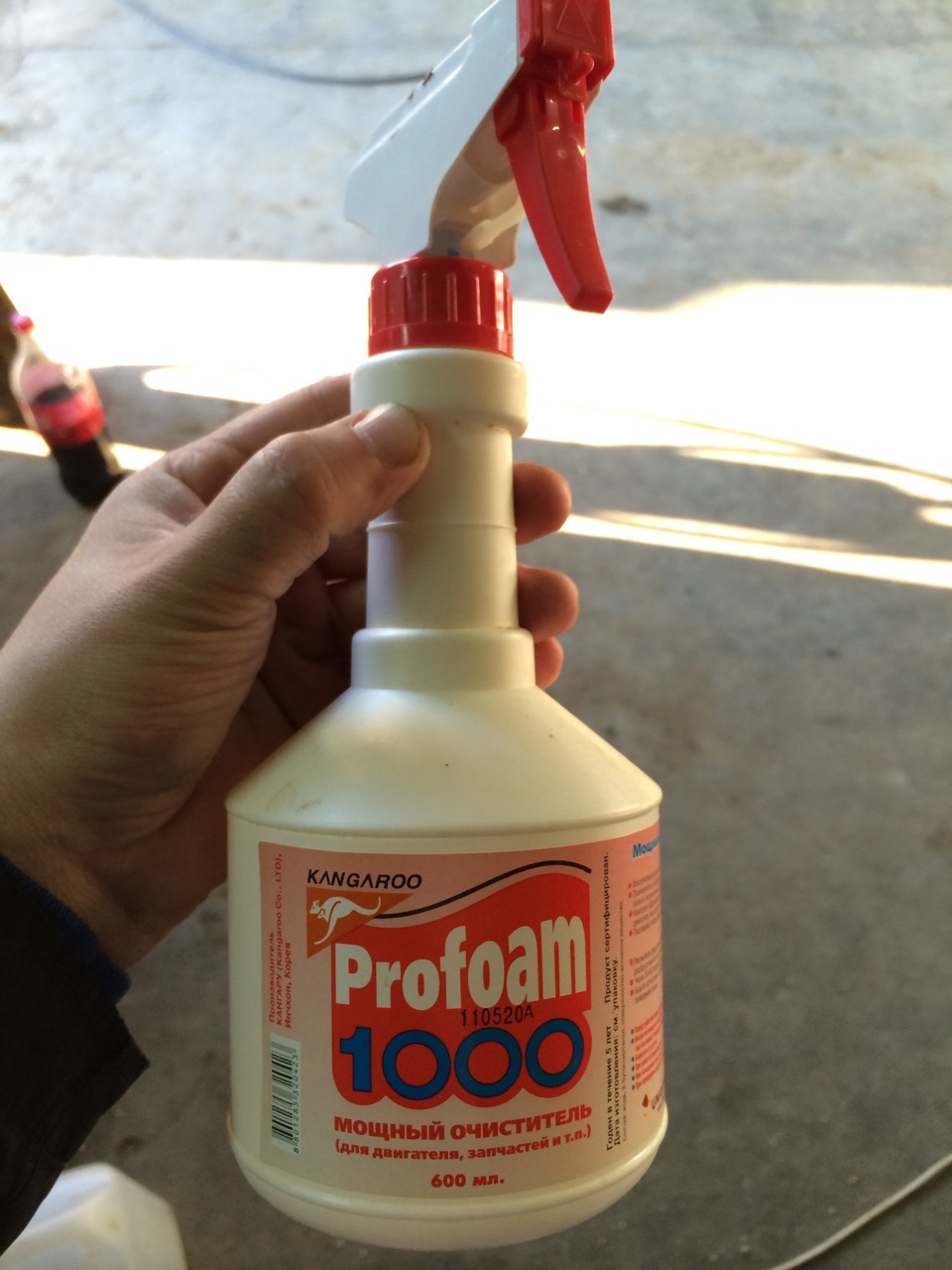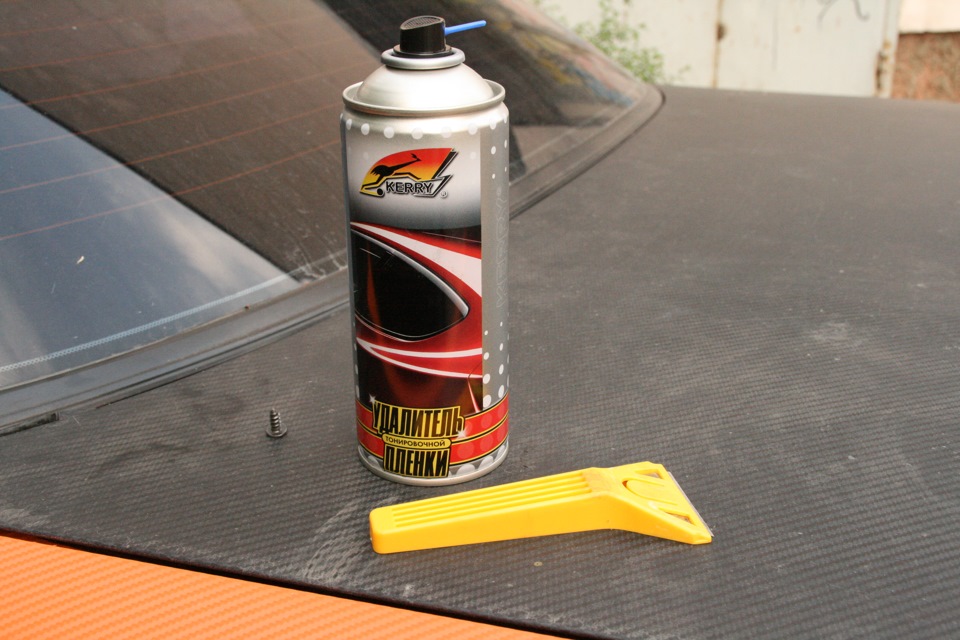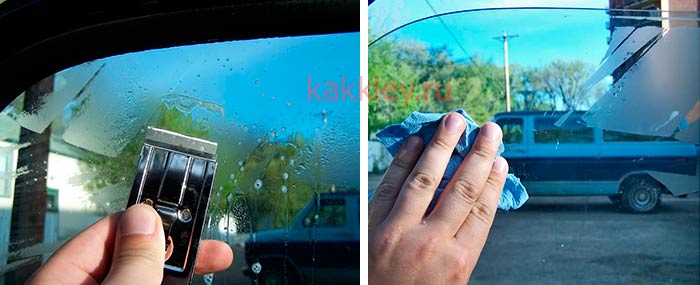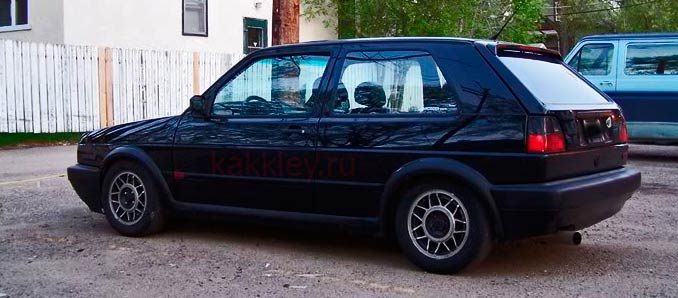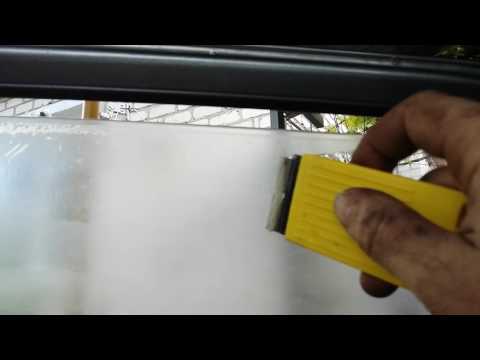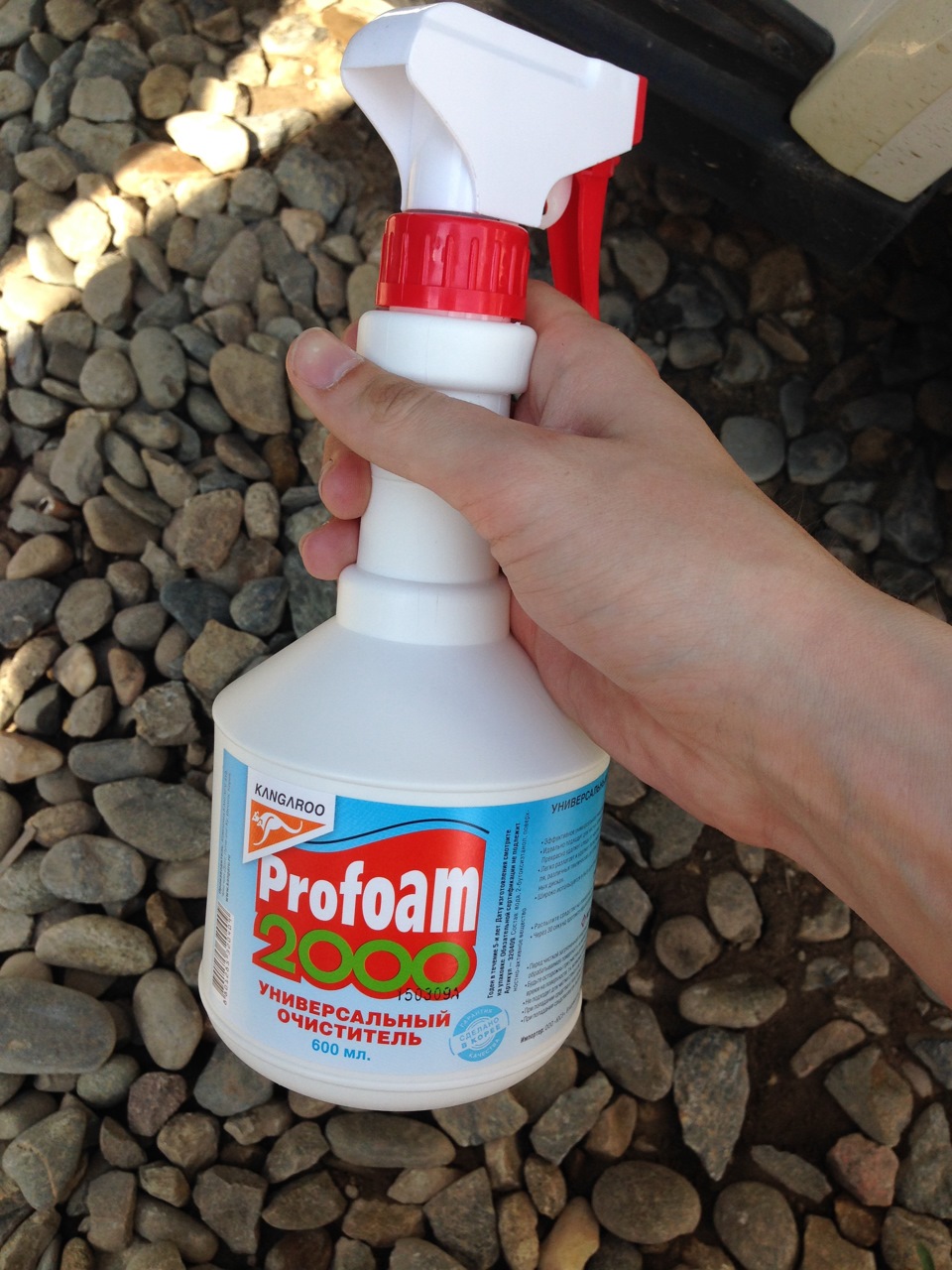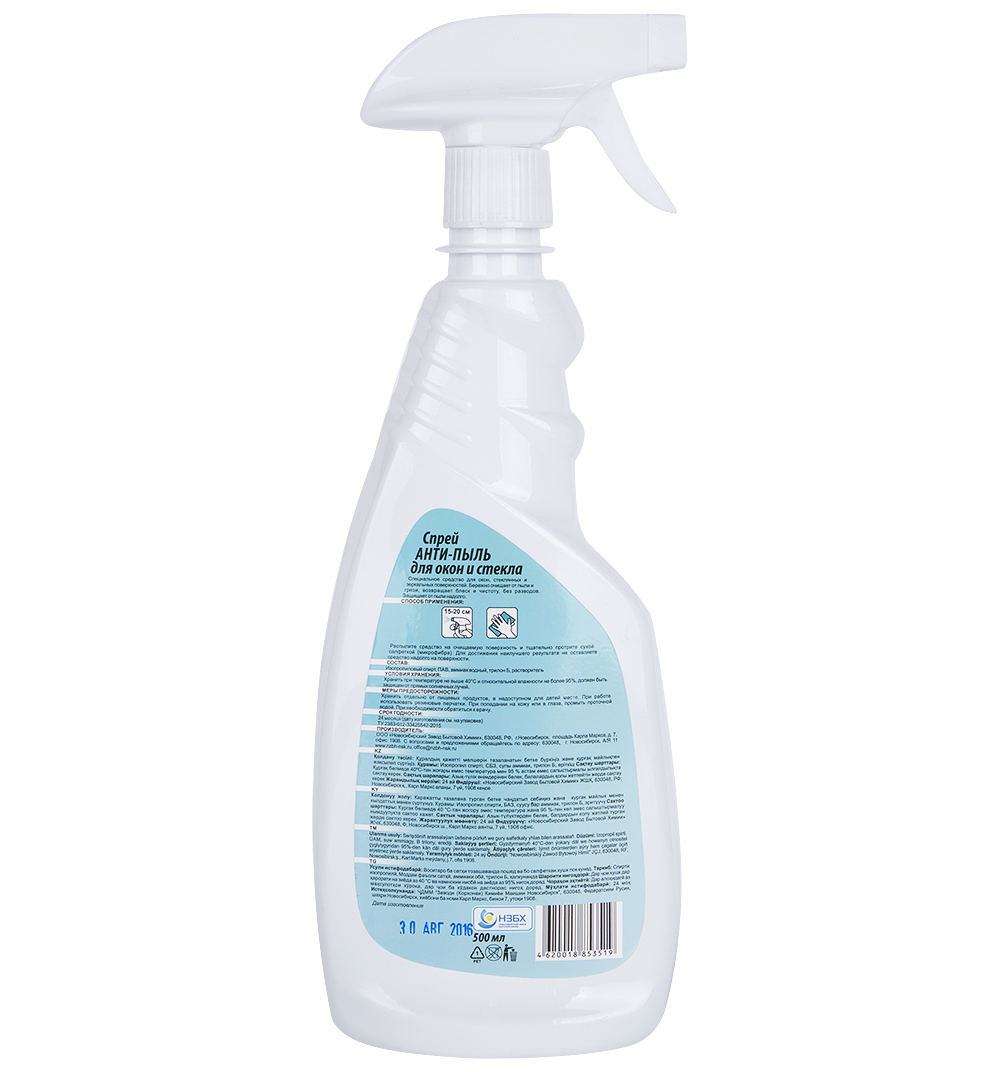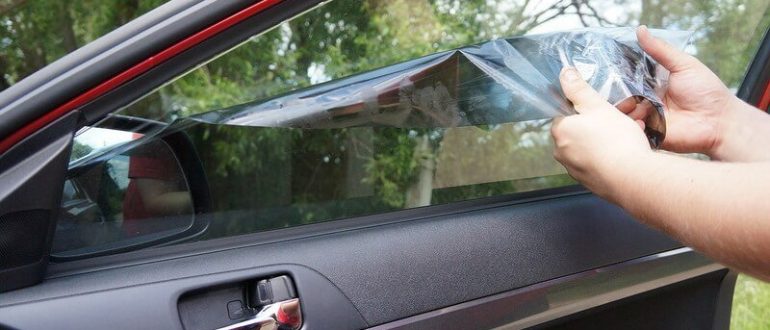We remove residues with professional chemistry
Mechanical and chemical methods are outdated surface treatment methods. Low productivity, the risk of damage to parts during processing are serious arguments in favor of new, more modern cleaning technologies. There is a wide range of products on the market that will help you quickly and efficiently remove the glue. These formulations include universal spray liquids for removing tinting. They are sold at any car dealership. The assortment is presented by domestic and foreign products, which allows the car enthusiast to easily choose the most cost effective option.
How to clean glass tinting glue
Situations often arise in which immediate removal of the film is required. In this case, a large amount of glue remains on the glass. To minimize the remnants of the composition, you can only quickly break off the tinting in one go.

How to wash the glue after tinting:
- liquid with soap;
- degreaser;
- solvent.
You can effectively and quickly get rid of the glue using caustic chemicals with a joint blade or scraper.
When working with solvents, it is necessary to remove the trim from the door, since if liquid gets in, it can change the color shade or swell.
Soap solution
A neutral liquid works well for a heated window. Remove the glue with a soft cloth that will not scratch the threads.
To soften the glue, apply the liquid to the glass and wait 10-15 minutes. After dissolving, remove the adhesive with a cloth. The process is quite laborious and can take a long time.
Degreasing solution
It is difficult and time-consuming to wash off the glue with a soapy composition. You can speed up the process with a sponge and degreaser.
To dissolve the adhesive:
- Spread liquid over the surface.
- Wait 3-5 minutes.
- Apply the composition to a sponge and wipe off the glue in a circular motion.
To speed up the process, the adhesive areas can be passed with a blade before washing with a sponge.
When working with sharp objects, it is important that the glass is wet, otherwise scuffs and scratches may appear
Use of solvents
Gasoline and acetone do an excellent job of removing the sticky layer after removing the film. To remove the glue, you will need:
- sponge;
- stationery knife;
- napkin;
- solvent.
The liquid is applied to the glass with a napkin and is evenly distributed over the surface. After softening the glue, it can be easily removed with a knife and a sponge.
Clean glass provides excellent visibility in any weather and reduces the risk of accidents. After removing the tinting from the side windows, the mirror effect during twilight will disappear and the view will improve.
How to remove tinted rear window

Removing the tinted rear window with heating
Basically, the procedure is the same as when removing tinted side windows.
The only difference is that you need to work very carefully so as not to damage the heating threads of the glass. Of course, there are compounds on sale for their restoration, but usually their use does not bring results - either the goods are mostly of poor quality, or the repair technology is not followed.
Therefore, it is better not to risk it and when peeling off the film, heat the glass with a hairdryer.
In addition, it will be useful to turn on the heating itself - at least the adhesive layer will be softened along the threads.
When removing any glue residue, do not use excessive force or move your hand along the threads.
Why do you need to remove tint
Removing the tint is a laborious job that requires no less skill than applying it.Therefore, the choice of removal method depends on the reason for its removal. For example, a newly pasted film is much easier to remove than an old one. Consider the most well-known reasons for removing tinting from a car.
- If the film begins to peel off, lighten, or any defects appear, then it is better to replace it. She no longer solves her problems, spoils the look of the car. Most often, the coating will fade quickly if non-metallic dyes are used in it. Bubbles can appear due to a poor-quality tinting sticker, or a poor adhesive composition.
- If, after buying a tinted car, you see that the film is too dark, you need to replace it. Otherwise, you may be fined. In the SDA it is written that the tinting of windows is allowed only within certain limits. For example, the windshield must transmit at least 75% of the light, and the front side windows must transmit more than 70%. In addition, a dark stripe at the top with a width of up to 150 mm is permitted on the windshield. If the traffic police inspector detects violations of the rules, then he can draw up a decision on punishment in an administrative order.
- If a crack or other serious damage appears on the window, then the tint must also be removed. Otherwise, it is impossible to repair the glass or replace it.
- Technological progress has contributed to the emergence of new types of tint coatings. If you want to equip your car with modern innovative film, then the old one will also have to be removed. On sale you can find electronic, athermal films, "chameleon", and other types.
 Car owners often remove tint due to a mismatch in light transmission. It is dangerous to ride with her, besides, you can get a fine from the traffic police inspector who will stop you on the road. If the violation is revealed for the first time, a fine of 500 rubles is provided for this. The second time, you will have to pay 1000 rubles.
Car owners often remove tint due to a mismatch in light transmission. It is dangerous to ride with her, besides, you can get a fine from the traffic police inspector who will stop you on the road. If the violation is revealed for the first time, a fine of 500 rubles is provided for this. The second time, you will have to pay 1000 rubles.
Features of working with the rear window of the car
Removing the tint from the rear window is much more difficult than from the side windows. On its surface there are heating threads, which are thin strips of metallized paste, opened with varnish. They are not always highly durable and cannot withstand severe mechanical stress.
The quality of the threads depends on the paste, the age of the car, the brand of the film. It is impossible to determine their condition. Therefore, it is impossible to be sure of maintaining the integrity of the threads after toning.
In this case, you should use a hair dryer or steam generator to remove the film. The procedure should be carried out very carefully, without making any sudden movements. This requires the coordinated work of two people. If the film is removed smoothly, the threads will remain intact. If they break off, you will have to change the glass or carry out repairs using conductive glue.

How to remove tinted rear window with heated
It is more difficult to remove the film from the rear window, which has heating. How to remove the tint without damaging the heated glass? To do this, you will need the same tools that were described above, as well as a technical hairdryer. Keep in mind that if you also have a high-quality film on your rear window, it will be much easier to remove it than to do it with Chinese products. And the guarantee that you do not damage the heating is also higher.
To remove the tint from the heated glass, heat it with a hair dryer, then pry the edge with a blade and slowly pull the film along the heating lines while continuing to use the hair dryer. But, with a high fever, don't overdo it!
Usually, a good film is removed easily, leaving the heating intact. Remains of glue must also be removed, but it is undesirable to use a blade or scraper for this, because it is very easy to damage the heating.
Types of adhesives used and factors affecting their density
The glass cleaning method should be selected taking into account the adhesive used when gluing the film.The most common options are the following:
- PS (Pressure Sensitive) is a glue that forms a bond when parts are pressed against each other. A striking example of the use of this adhesive is adhesive tape. The adhesive layer is an elastomer with the addition of tackifiers (ether, rosin). The easiest films to remove are with an adhesive acrylic layer. Until the composition completely solidifies in air, which occurs after removing the film, it can be washed off within a few minutes with plain water.
- DPS (Detackifier Pressure Sensitive). Films with this abbreviation are provided with a layer of water-soluble glue. One of the varieties of the group are stickers marked with PS / DT. To attach to the surface, they must also be moistened and pressed against the glass, having previously removed all excess liquid from the surface.
- CD. Temperature-activated adhesive.
- CDF. The abbreviation stands for a group of two-component adhesives. Such films require additional installation solution.

It is especially difficult to remove the tint and glue after it from the rear window.
The brand of glue on the films may not always tell you how to remove the sticky layer from the glass. To increase the strength of the connection, manufacturers add additional components to the base compositions, so often the search for a way to clean the glass from a car is carried out empirically.
How and what not to remove the tint from the windows of the car
A large number of motorists make a serious mistake when trying to remove the tint film with improvised means, without realizing the peculiarities of this procedure. In practice, there is a significant danger of damaging the glass of the car and facing the bleak prospect of replacing it. This is especially unpleasant when trying to tear off the tinted film from the windshield.
First of all, it is impossible to remove tint using mechanical solid objects - a knife, scissors, etc. Such attempts will lead to the appearance of scratches on the glass surface, which can be both clearly visible and distinguishable from a certain angle of view.
Another mistake motorists make is an attempt to use aggressive chemical liquids, for example, acetone and the like. The fact is that attempts to dissolve the adhesive base of the film lead to the destruction of the tinting layer itself and its much denser adhesion to the glass, an effect is created as if the tinting has become attached. In addition, chemical compounds can easily damage body paintwork, as well as window seals, which can be completely destroyed as a result of such experiments.
Sometimes a car enthusiast has the deceptive impression that the film will be removed easily and quickly, and for this it is enough just to pry off its edge. This approach is deceiving and leads to the fact that pieces and dried glue remain on the glass, which is very problematic to remove.
How to wipe off with chemicals
Solvents will help speed up and make the process of removing the sticky layer from glass more efficient. Most often, motorists use white alcohol, gasoline, kerosene, acetone-containing compounds, liquids for washing carburetors, etc. To remove contamination, the area is moistened with a solution, left for a short time and the main layer is erased with a soft scraper. After that, they perform finishing and wipe the surface dry.

Before treating glass with such liquids, it is necessary to carefully protect all adjacent surfaces, otherwise financial losses will be higher than if the tinting was removed by professionals
The main advantage of the method is its low cost and versatility. The above funds are cheap and can be purchased at any hardware store. The disadvantages of this method are:
- Risk of damage to seals, interior surfaces of the passenger compartment. Rubber or plastic is destroyed on contact with a solvent.Accidental spraying of the solution will stain the upholstery or trim.
- High toxicity of funds. To avoid cases of poisoning, do not inhale solvent vapors for a long time. Considering that the processing is carried out inside the cabin, the car owner must provide for an effective method of ventilation or refuse to use the method if it is necessary to process large areas.
Removing tinting on your own
To remove the sticker from the glass of a car quickly and efficiently, you can use the following methods:
- heating the surface;
- soaking with soapy water.

Both solutions allow effective material removal with minimal glue residues on the part. When performing work, the film is gently pry off with a sharp blade from the corner and stretches downward.
Hot air removal
A proven and effective option is the removal of material by heating. To remove with your own hands, you will need tools:
- industrial dryer;
- knife or blade;
- gloves.
In order not to burn your hands and melt the film, it is heated from the outside. On the hair dryer, the temperature is set at + 100 ... + 150 ° С and the average blowing speed. Additionally, you can use the heated rear window to speed up the removal process.
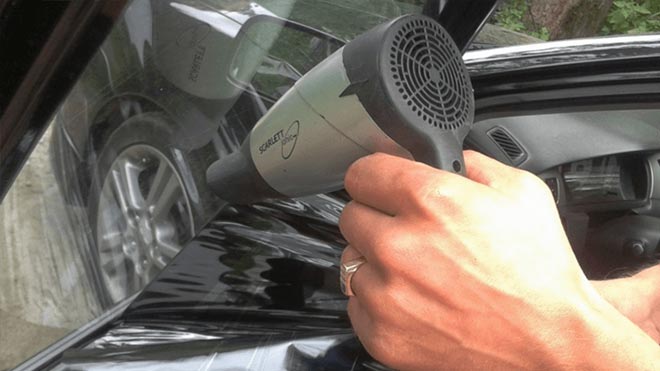
How to remove the old tinted rear window:
- Wash the work surface.
- Remove the decorative plastic from the uprights in the passenger compartment.
- Turn on the hair dryer, warm up one of the upper corners of the shield in a circular motion.
- When the temperature reaches 40 to 60 ° C, gently pry the corner with a blade.
- Gradually remove the tint downward, avoiding creases and heating the surface from the outside.
- Remove tint carefully.
You can also tune the side windows with your own hands using a hair dryer. To tear off the corner, you need to lower the glass, pry off the tinting and continue removing as usual.
When working with a hairdryer, you must observe safety precautions: do not take the device with wet hands, do not point at explosive objects. When warming up, you do not need to stay in one place for a long time, since a sharp spot heating can lead to the formation of cracks.
The method ensures the complete absence of glue residues on the glass when using expensive tinting. Chinese materials leave adhesive spots and streaks.
Using a soap solution
A regular soap solution will help to wash off the tint from the glass of the car. The liquid softens the glue, and the film is removed without much effort. The disadvantages of this method include:
- wetting of the door trim and rear window shelf;
- incomplete dissolution of the glue;
- large labor costs during dismantling.
This method is quite long. To completely remove the tinting, you will need at least 1-2 hours of free time. This option is suitable for drivers who do not know how to remove stained glass from glass without using caustic chemicals.
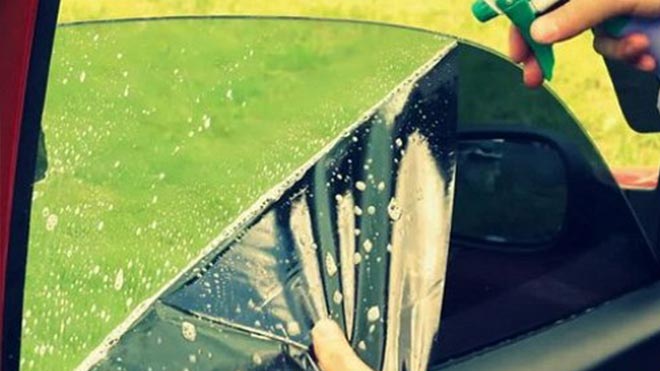
To carry out the work, you will need materials:
- spray bottle with soapy liquid;
- blade;
- clean cloth;
- rags to protect the interior plastic elements.
How to remove the glass sun protection film:
- Prepare a soap composition and pour it into a spray bottle.
- Pry off a corner of the film with a razor or knife.
- Place fabric on door card or rear window shelf.
- Moisten the inside of the torn off corner with liquid and let it soak for 5-10 minutes.
- Carefully remove the tint down and re-saturate with the solution.
Gradually peeling off the film and soaking it in liquid allows you to get rid of the greatest amount of glue. There is a method using soaked newspapers. The paper must be laid on a film and left for 2-3 hours. The adhesive swells and the material is removed from the glass surface.
How to properly remove tint material
There are several options for removing tinting material. To achieve good results, you should strictly follow the technology of the procedure.
Remove with a quick motion
In this case, it is recommended to pick up the tinting with a sharp object and, holding firmly with your fingers, pull it off sharply. This method helps to quickly remove the film, but it is considered to be of insufficient quality.
3> Slow deletion
The film can be removed slowly by gradually heating it up. First, you should pick up the edge with a sharp object, after which hot air should be supplied with a building hairdryer. The material should be heated to a maximum temperature of +60 degrees. Only in this case it will be possible to neatly remove the material. During heating, the adhesive mixture comes off with the film.
Using a soap solution
If the glass cannot be heated, it is permissible to remove the tinting with a soapy solution. In this case, the film should be pry off with a knife and carefully pulled off, applying a soap solution to it. To reduce the adhesion characteristics of tinting, it should be poured abundantly with liquid in the joint area.
Ammonia solution
There are situations when the glue fixes the film very tightly to the glass. In this case, it cannot be removed by heating or other methods. To remove the tint, you can use an ammonia solution or ammonia, which you can buy at every pharmacy.
Before carrying out work, it is worth putting on a respirator and protecting the adjacent surfaces. To remove the tint film, do the following:
- apply a soapy solution to the glass;
- cover the tinting with ammonia;
- cover with plastic wrap - this helps to avoid evaporation of alcohol;
- sprinkle with ammonia solution and wait for the film to begin to lag behind the glass;
- after 10 minutes, the material will begin to wrinkle - at this point it should be removed.
Due to the creation of greenhouse conditions, the structure of the adhesive layer is disrupted. Thanks to this, the tinting easily moves away from the glass surface.
Removing the remnants of glue from the tinting from the rear window
It must be remembered that there are heating lines on the rear window. Using a sharp object to scrape off any adhesive residue from the tint film can damage these lines.
Before removing the adhesive from the rear window of the car, you must remove all obstacles that interfere with the process. This could be a brake light, speaker covers, etc.
You need to cover the rear shelf with plastic or tarpaulin so that the product does not get on it.
Next, you need to soak the adhesive residues for a few minutes with one of the above-described agents (cleaner with ammonia, alcohol or acetone). The next step is to use a soft steel sponge. It will not damage the heating lines and will cope well with traces of glue from the removed tint film.
Also, you can read the article on the correct removal of the tint film.
How to remove tint from glass yourself
High-quality American-made films can be removed quite simply. How to quickly remove such a tint?
The side window needs to be lowered a little - the tint film is usually not glued flush with the edge of the glass, but with a slight deviation from it - by a few millimeters. It is enough to pry the edge of the film with the blade of an office knife.
Next, tear off the film along the entire width of the glass so that its edge can be comfortably gripped with the fingers of both hands. Pull it down and tear it off, lifting the glass at the right time.
If the glass is pressed tightly enough to the sealing gum, it can be removed by first lowering the glass to the stop - this way the film will not come off at the edges afterwards.
But tinting films made in China are of poor quality. To their main disadvantage - they fade quickly - there are also difficulties associated with peeling off the film. As a rule, the film is not separated from the glass in a wide layer, but is torn off from it in narrow stripes.
Tint film characteristics
Car glass tinting allows drivers to reduce the heating of the cabin by the sun's rays, improve the appearance and hide the contents of the cabin.

Toning meets the following characteristics:
- the degree of light transmission;
- shade;
- glue base;
- UV protection.
For the parameter of light transmission, the percentage on the package with the film is responsible. The higher the value, the lighter the shading. There are several main types:
- 5%;
- 10%;
- 15%;
- 25%;
- 35%.
The back hemisphere is usually pasted over with a material with an indicator of 5%. This provides a serious blackout of the interior and does not interfere with the driving vision.
The shading of the strip on the upper part of the windshield is done with 10-15% toning. The choice of this value is justified by the fact that the film transmits a lot of light, so that the driver is not distracted while driving. The strip width should not exceed 140 mm at any point of measurement.

It is forbidden to darken the front side windows, but drivers ignore the rules and apply material with 35, 25, 10 and even 5% markings. In sunny weather, this practically does not affect visibility, however, at dusk or rain, the film gives glare and reflects the driver's face, seriously impairing the view.
The shade of the material depends on the choice of the buyer and can be:
- black;
- dark blue;
- blue;
- dark brown.
In Chinese models, there are shades of red, green and yellow. Original expensive materials are usually offered in black or blue colors.
The tinting is adhered to the surface due to a special transparent glue. The quality of the composition directly depends on the manufacturer and the cost of the product. On cheap materials, hazy spots often appear, significantly impairing visibility.
Ultraviolet radiation has a negative effect on human skin, elements of the center console and leather upholstery of the seats. High-quality tinting includes spraying that refracts harmful rays. Cheap products cannot boast of such an ability.
Quick removal of glue residues from the glass surface of a car
We have previously described how it is relatively easy to remove the adhesive after removing the film. However, there are times when the glue leaves streaks that are not easy to deal with. In this case, in addition to the direct use of solvents or acetone, you can use a cloth impregnated with them, which is applied to the area and held for 5-10 minutes. As a rule, this is enough to dissolve the glue and subsequently its remnants can be easily removed with conventional detergents.
As you can see, removing the tint film is a relatively simple procedure, but quite specific and requires certain knowledge. In fact, the theory does not always help, and for confident work it makes sense to test these recipes on one of the side door windows. Only after you have mastered the skills, it makes sense to start removing the film on the rear window and other critical areas of the glazing. Then you can be sure of the final quality of the work done.
How to properly remove tint (for the future)
To leave a minimum of glue from the film, you need to know how to properly peel off the tint from the glass. To carry out dismantling, you need to prepare:
- Building hair dryer;
- Stationery knife.
The procedure is as follows:
- Using a utility knife, pry a corner of the tint film so that you can pick it up with your fingers.
- Heat the hair dryer to 300-400 ° C.
- Preheat the starting point.
- Begin to pull the film lightly. The heated glue liquefies and lags behind the glass.
- Cut off large pieces of the removed film with a clerical knife, this will simplify the process.
> It is easy to wipe off the adhesive after removing the tint film if you choose the right method. In order not to damage the glass, you need to use only proven methods and tools.It is possible to simplify the procedure and minimize the amount of glue residues by properly dismantling the tint film.
How various gadgets are attached to the windshield
Renowned manufacturers of specialized automotive devices have recently been trying to avoid the use of adhesives for attaching devices to the windshield. Instead, they prefer suction cups that hold devices securely in place and leave no residue.
But if the device was not originally intended for a car, or its manufacturer decided to use an adhesive when attaching to reduce the cost of production, problems will arise after removing such a gadget.
The adhesive composition can be one-sided and two-sided. In the first case, a small adhesive layer will remain on the glass after peeling off, in the second version, a rubberized element may remain with it.
Withdrawal errors
At first glance, the work seems simple if you look at the actions of the masters. Many drivers think they will be able to remove the film by prying it over the edge and tearing it off abruptly. The operation is actually simple, but it takes skill. After all, you need to remove the darkening completely so that there are no pieces of material, glue stains. There are several subtleties in this work, and incorrect actions can lead to glass replacement and money spending.
- The use of sharp, hard objects: knives, scissors, which can scratch the glass.
- Use of acetone and chemicals containing it. This will cause the coating material to adhere, dissolving the tinted layer. Aggressive fluids can damage rubber seals and body coatings.
Self-removal of tinting is a simple procedure if you prepare everything you need and follow the described recommendations.
We use household tools
Another way is to use a degreasing solution, which can be prepared from regular dish detergent. We make foam out of it and apply it to the glass, then wait for it to dry. After the foam dries, the surface remains to be washed off with a mild abrasive. To do this, you can use the hard side of a regular dishwashing sponge. The glass is wiped dry with a rag.
Among the popular means for removing glue, you can find oily ones. It can be gasoline or kerosene, acetone, white spirit - there will certainly be a suitable remedy in your garage. We wash the glass with these solutions, and then carefully clean off the remnants of the glue.
It is necessary to remember about the toxicity of these funds, so do not forget about the precautions. And take your time so as not to spray the upholstery, seats
Alternative processing options after removing the film
In the matter of removing glue residues after tinting, such types of household chemicals as:
-
Rust converter Star Wax. Russian product. It is produced in the form of a liquid in 0.5 liter bottles. The effectiveness of the composition is confirmed by numerous reviews of motorists: it is possible to erase the glue without leaving a residue quickly and effortlessly.
-
Means "Super Moment Antikley". It is produced in the form of a tube with a volume of 5 g. It is a gel that is applied to a stain or glue line and dissolves them.
-
Bio-solvent Citosol. Effectively copes with the problem of cleaning the surface from adhesives based on bitumen or vinyl.
-
Profoam 2000. A universal tool for removing stickers from any type of surfaces - outdoor advertising on cars, decorations on the refrigerator and doors, etc.
-
3M 08184. Universal cleaner for various types of adhesives. Available in aerosol form. After irrigation, it remains only to wash the resulting waste from the glass.
Easy way to remove marks with soapy water and newspaper: video guide
There is no one-size-fits-all advice on how to remove glue after tinting.The strength of the layer is influenced by the type and brand of the sticky layer, the duration of the coating and the quality of the film laid down by the manufacturer. You can find an effective solution in your case by testing the proposed options. Automotive technicians are recommended first of all to use tools specially designed for this type of work. If they prove to be ineffective, try mechanical or dry cleaning of the glass. With a large area of contamination, it is advisable to purchase universal products from the section of alternative options or contact a workshop for help.
How can you wipe off the glue after tinting
There are several means for removing glue after tinting - from cheap "home" ones to those that can be purchased in a store.
1. Soap solution - the most affordable option for a product that can be easily prepared from soap and water. It is also worth adding a little ammonia. The advantages are cost and availability. But the effectiveness of the soap is low, it will only help if there is little glue left.
Alternatively, you can use dish soap or any glass cleaner.
2. White spirit. This solution is sold in all hardware stores and costs about 370 rubles. The advantages of this tool are availability, in some cases it shows excellent results.
When using white spirit, it is important to remember that it is quite toxic. Be careful not to get the product on the seats and upholstery.
3.Special spray for removing tint (KERRY, KUDO for removing tint film). Designed specifically to remove glue residues from glass. Of the advantages, it is worth highlighting the ease of use - the composition is easily sprayed from the can, as well as efficiency - the glue is quickly removed after dissolution with this tool. Disadvantages - high toxicity and price - from 400 rubles.
4.Rust converter Star Wax. Sold at hardware stores, easy to apply with a spray bottle. In practice, it shows high efficiency - it quickly acts on the glue, after which it is easily scraped off. The cost is about 80 rubles.
5.Super Moment Anticlea. Designed to remove any glue stains, including glass. It is often used by specialists in car repair shops. The consistency is similar to a gel, it is convenient for use on vertical surfaces. The cost is about 150 rubles.
6. Glue cleaners ZM 08984 and 3M 08184. They are also often called "orange" because of their specific smell. In addition to glue, mastics, oils, silicone are removed. They do not leave traces and at the same time do their job well. The cost is about 1100 rubles.
7. Bio-solvent Cytosol. Copes with the removal of bituminous and vinyl adhesive components. The product is not toxic, so you can safely use it. It is not easy to find Cytosol in stores, and in this case this is its main drawback.
8. Means for repelling moisture, for example, "Antirain" (cost about 150 rubles) or spray WD-40 (price about 300 rubles). The active ingredient in the products helps to dissolve the glue residues.
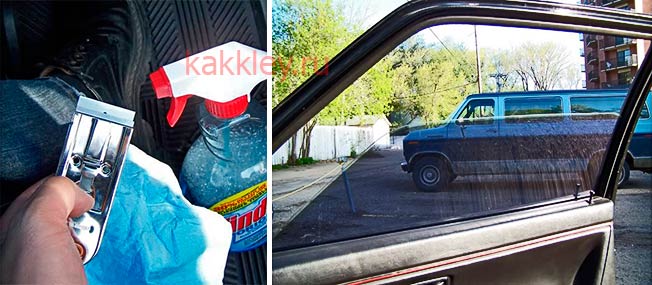

Removing glue after tinting - instructions
Important! To minimize glue residues, the tint film must be removed correctly. To do this, you must first heat it up with a hairdryer, and only then remove it.
If the film needs to be removed from the side glass, lower it to the middle and pry off the top edge with a knife
To do this, you must first heat it up with a hairdryer, and only then remove it. If the film needs to be removed from the side glass, lower it to the middle and pry off the top edge with a knife.
There are several ways to wash off the glue after tinting. Let's consider the most effective ones.
Option 1: scraping + soap solution
This method can be called the most popular.
For work you will need:
- soft scraper,
- spray,
- soap solution.
Procedure:
- We heat the area with glue with a hairdryer to a temperature of 40C. At the same time, we apply a soap solution.
- Holding a knife or scraper at an angle of 30-40 degrees, gently scrape off the sticky adhesive layer.
- We treat small areas with glue again with soapy water, and if there is a lot of glue, add ammonia to the solution, it will speed up the process.
Option 2 - use a glue remover spray
For work you need:
- spray,
- soft spatula.
Procedure:
- We apply the product to the area with glue.
- We are waiting for a few minutes for the reaction to start. The product will begin to dissolve the remaining glue.
- Take a soft spatula and gently scrub off the residue.
VIDEO DESCRIPTION
Option 3 - dissolve the glue with a rust converter
We will need:
- Star Wax,
- spray,
- soft sponge.
Algorithm of actions:
- Spray the product on the glass and leave.
- After the glue dissolves, scrape off the residue with a soft sponge.
How to remove glue from tinting yourself
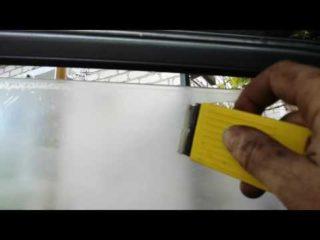 The most common way to remove glue is by scraping with a special scraper.
The most common way to remove glue is by scraping with a special scraper.
You can glue the film with different types of glue, therefore, the cleaning methods are different.
The adhesive applied to the film is the adhesive coating. It connects materials of different structure by surface adhesion. It usually contains resins, adhesives of several types, bitumen, vinyl and other components. The service life of the tint coating depends on the quality of the adhesive, therefore it is not always easy to clean the glass from the adhesive residues.
The most common way to remove glue from car windows is by scraping or cutting. This procedure is carried out using a special spatula, scraper or plastic card. If not, you can use a regular razor blade. In this case, the scraper must be held at an angle of approximately 30-40 °.
The remains of the sticky base must first be moistened with a soap solution. To speed up the dissolution process, you need to add a few drops of ammonia to the liquid. During cleaning, you need to be extremely careful not to injure yourself or scratch the surface.
Special means
There are many products on the market to remove glue residues from tinting:
- Kerry spray and other special film removers. Thanks to aerosol packaging, they are easy to apply to the surface and effectively dissolve the glue. It is necessary to apply to the glue spot and wait a little. Then clean the surface with a soft spatula. The product is toxic and expensive.
- Super Moment "Antikley" is a new preparation, created specifically for dissolving glue spots. It resembles a gel in its consistency, it is convenient to use it.
- Rust converter "Star Wax" helps to wash off the glue, quickly acts. Sold at hardware stores. The converter must be applied to the car glass, and then scrape off the remnants of the film and wipe the surface thoroughly.
- Bio-solvent "Cytosol", which dissolves vinyl and bituminous components. Not hazardous to health. Its main disadvantage is that it is difficult to find the drug on the market.
- Adhesive cleaners ZM 08184 and ZM 08984 clean well and do not scratch the glass surface. These products are sometimes called "orange" for their peculiar smell.
- Profoam 2000 is a universal household cleaner that is used to remove adhesive tape and various stickers.
- “Bug Blitz”, “Resin & Bug Remover” and similar fluids used to clean the body and headlights from traces of insects and silicone deposits.
- Turtle Wax Clear Anti-Rain is a water repellent agent. The active ingredient is capable of dissolving glue spots.
You can try wiping off the adhesive from the film from the glass with any dish detergent. An aqueous solution is made with abundant foam and the glass is moistened. After drying, it is washed off with a sponge with a soft abrasive, that is, the hard side of a washcloth. And wiped dry with a rag.
It is best to remove the tint film in the summer. In winter, you need to work in a warm garage.If this is not possible, it will be necessary to apply abrasive compounds many times until the adhesive base dissolves until it can be cleaned with a sponge. You may need to change your medications several times.
Folk remedies
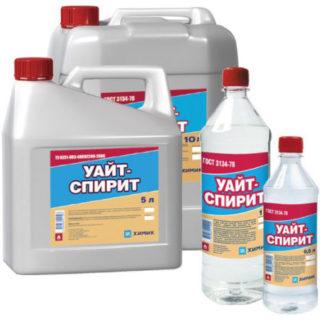 Petroleum based white spirit removes adhesive well from film
Petroleum based white spirit removes adhesive well from film
Pepsi and Coca-Cola are considered the best tools at hand that can be used to wash the glue from glass tinting. You just need to wet the surface of the window with a drink, wait a little and you can clean it.
Any substances made from oil are considered folk remedies:
- petrol;
- kerosene;
- acetone;
- White Spirit.
Alcohol is considered to be another effective glue remover.


